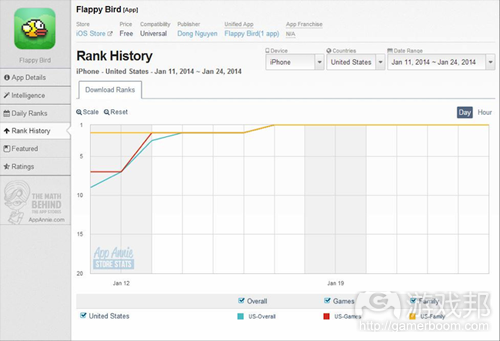评《Flappy Bird》的评价机制如何推高游戏排名
作者:Michael Silverwood
如果你曾自主发布过一款手机应用或游戏,你可能就会针对《Flappy Bird》神话而自问:它究竟是如何在一开始就称冠App Store榜单?
当然,已经有许多文章探讨过它如何“病毒式传播”,为何其玩法具有“成瘾性”—–但正如多数应用开发者所知,这些并非其初始发展的真正动力。没错,你的确需要一款过硬的产品,并且如果其设计具有内在病毒传播性,你当然会获得巨大的优势,但在这些属性生效之前,你还需要首批大规模的下载量来作支撑。
所以一款零营销投入的游戏究竟是如何冲向许多发行商至少要投入8万美元通过付费用户获取渠道,才能问鼎的App Store排行榜顶端呢?我相信《Flappy Bird》的这一成就完全要归功于用户评价。
为了理解其中原因,你首先要知道App Store排名算法运行原理。苹果很显然不会公开这一信息,但据称许多应用开发者认为该应用商店当前的排名算法类似以下公式:
排名=(过去数小时的安装量)+(过去数天的安装量)+评价(星级评价+评价数量)+粘性(应用开启次数)+销售额
《Flappy Bird》在12月份从零下载量一跃升至成千上万次下载量,通常这可以通过付费营销(购买安装量)而促成。但是,目前没有任何证据显示其开发者在传统的用户获取渠道上投入资金,那么一款应用还会通过什么方法在如此短暂的时间内晋升至榜单前列?
多数开发者关注的是安装量,但这里要注意的是苹果很重视用户评价和粘性。有人称《Flappy Bird》开发者Dong Nguyen可能使用了刷排名的工具来推动下载量和评价游戏,虽然这当然会促成首轮下载量,但似乎还有一些更为简单的东西可能是其首轮用户评价潮出现的原因。
在游戏的早期版本中,玩家每次访问结束时都会出现一个“评价”按钮,但这个按钮处于玩家可以点触玩游戏的同个地方。因此,如果玩家想继续玩游戏,就很容易点击到评价按钮。这就是所谓的黑暗模式:即用户界面设计有意引导用户去做那些他们原本并不会主动去做的事情。用户在游戏结束时会条件反射式地记得玩游戏的按钮在哪里,并快速点击,但打开的却是App Store评价页面。
从Dong Nguyen如何设计《Flappy Bird》以及幸运获得成功的所有描述来看,这个按钮的位置可能是随机选择的,但值得注意的是它让用户评价推动了安装量的增长。
Zach Williams通过研究该游戏在iTunes的数据发现,当《Flappy Bird》晋升为第一名时,它每天收到了400条评价。一天之后,其每日评价达到600条,到1月底,它每小时所收获的评价就超过了这一数据。App Annie报告曾指出,《Candy Crush Saga》发布几乎一年半之后在美国所收获的评价总数也才40万,而《Flappy Bird》仅一个月就在美国收获了70万的评价数量。在它达到这一规模后,为该游戏iTunes评价也迅速成为一种病毒传播现象,游戏的黑暗模式也成了不必要的设计,并在更新版本中被移除。
虽然用户评价当然不是《Flappy Bird》的唯一成功因素,但我相信它们在游戏异常的生长曲线中发挥了极为重要的作用,也是游戏最有趣的数据点之一。(本文为游戏邦/gamerboom.com编译,拒绝任何不保留版权的转载,如需转载请联系:游戏邦)
How in-app review mechanics pushed Flappy Bird to the top of the charts
Michael Silverwood/Tandem Capital
Michael Silverwood is an Operating Associate at Tandem Capital.
If you’ve ever released a mobile app or game yourself, you’ve probably been asking yourself this same question through the whole Flappy Bird saga: how the hell did this game get to #1 in the App Store in the first place?
Sure, lots of articles have talked about how it “went viral” and why its gameplay is “addictive” — but as most app developers know, these are rarely the true drivers of initial growth. Yes, you’ll need a kickass product and if you can design it to be inherently viral you’ll have a huge advantage, but before those attributes can have any impact you need your first critical mass of downloads.
So how does a game with zero marketing spend shoot to the top of the App Store rankings, a spot that many have estimated can cost over $80,000 through paid customer acquisition? I’m convinced that in Flappy Bird’s case, it all came down to user reviews.
To understand why, you first need to know how the App Store’s ranking algorithm works. Apple obviously doesn’t make this public knowledge, but anecdotally app developers have come to believe the current iteration works something like this:
Ranking = (# of installs weighted for the past few hours) + (# of installs weighted for the past few days) + REVIEWS (star rating + number of reviews) + Engagement (# of times app opened etc.) + Sales ($)
Flappy Bird jumped from nearly zero downloads to thousands back in December, something that is usually achieved through paid marketing (buying installs). However, there is no evidence that any money was spent on traditional user acquisition, so how else could an app rise up the rankings this quickly?
Most developers focus on number of installs, but the important thing to note here is that Apple also pays close attention to user reviews and engagement. Some have suggested that Flappy Bird developer Dong Nguyen might have used a bot service initially to download and review his game, and while this could definitely have sparked the first small wave of downloads, it seems that something even simpler could have been responsible for the wave of user reviews to come: a dark pattern.
In earlier versions of the game, there was a “rate” button at the end of each play session, and this button was placed in the same location that the player would tap to play. As a result, when the user wanted to continue playing, it was easy to hit the rate button instead. This is known as a dark pattern: when a user interface is designed to get users to do something that they would not otherwise intentionally do. The user reflexively remembers where the play button used to reside as they die, and quickly taps there, opening an App Store review page instead.
From all descriptions of how Dong Nguyen designed Flappy Bird and apparently lucked into its success, this button placement could have been chosen by chance as well, but what’s important is that it made user reviews relative to installs skyrocket.
By scraping the game’s iTunes data, Zach Williams was able to find that by the time it reached #1, Flappy Bird was receiving 400 reviews per day. One day later, it hit 600 reviews a day, and by the end of January it was receiving more than that per hour. To put these numbers into perspective, App Annie reports about 400,000 total US reviews for Candy Crush after almost a year and a half on the App Store, while Flappy Bird managed 700,000 US reviews in about a month. Once it hit this scale, writing hilariously detailed iTunes reviews of the game became a viral phenomenon, and the dark pattern was unnecessary and patched out in an update.
Although user reviews were definitely not the only contributor to Flappy Bird’s success, I believe the role they played was extremely fundamental in the game’s abnormal growth curve, and are one of the game’s most interesting data points. For a deeper dive into the review numbers, check out Zach’s full analysis of the App Store review numbers and let us know in the comments what you believe made Flappy Bird such a huge success.(source:venturebeat)
下一篇:分析游戏玩家社交化的6个程度








































 闽公网安备35020302001549号
闽公网安备35020302001549号